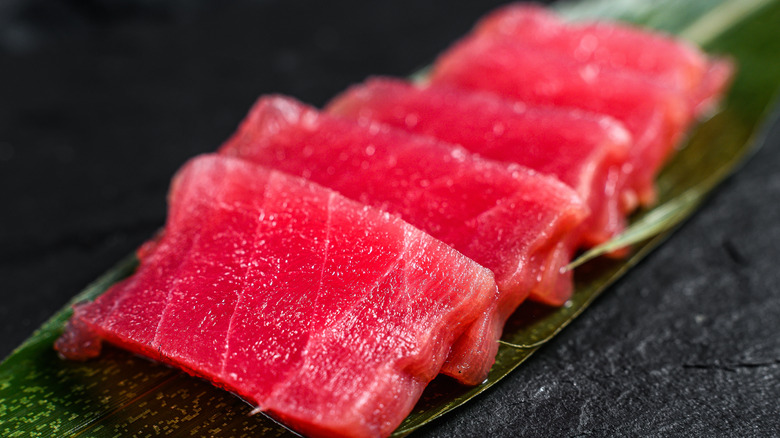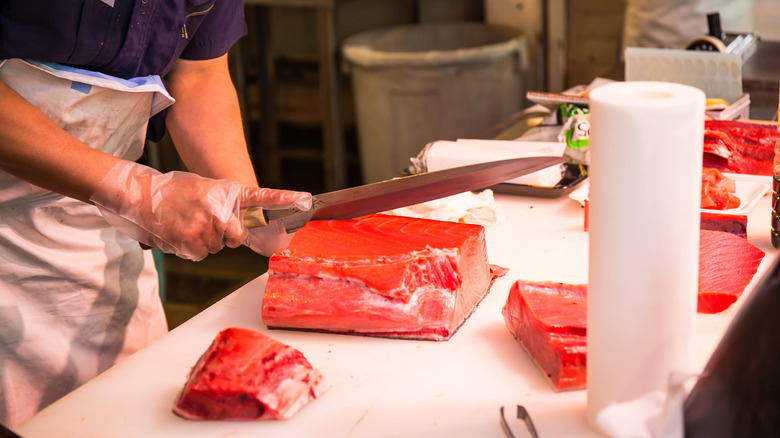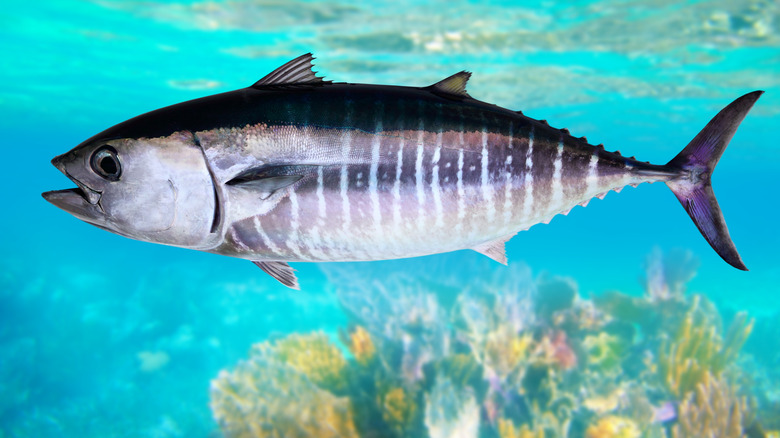Bluefin Vs. Bigeye Tuna: Which Is Better For Sashimi?
If you didn't attend fish school and are mostly used to consuming canned tuna, then Bumblebee and StarKist might feel like unofficial species. So with 15 actual tuna species roaming the world's oceans, per the International Seafood Sustainability Foundation (ISSF), it's probably easy to assume they're relatively similar in taste and composition. But when it comes to raw consumption, even subtle differences can be crucial, turning a so-so dining experience into an extraordinary one. That goes double for sashimi.
Rather than being accompanied by tasty vinegary rice, seasoned filling, and seaweed wraps like its sushi counterpart, sashimi sits bold, pretty, and alone on your plate, notes Healthline. Tuna-based sashimi, which is simply thin slices of raw fish, typically comes without sauces or flavorings. That's why the particular tuna species really matters.
Two of the primary tunas vying for sashimi affection, the bluefin and bigeye, share some desirable characteristics but diverge in other important ways. From color to texture, flavor, cut, nutrition, and cost, here's a look at how the two tuna species compare.
Making the cut might depend on how lean you like your fish
Both bluefin and bigeye tunas carry a striking deep-red color that works well for visual meal appeal, according to The Japanese Bar. Maturity affects color, so you'll sometimes find more pale reds in bigeye tuna due to fishing practices that target juvenile fish. Both species are fatty and flavorful, though subtle differences begin to appear.
Bigeye tunas, known in Japan as mebachi maguro, have a rich, sweet flavor that's clean and less "fishy" than other tunas. They're also firm and tender, which holds up well in raw sashimi form. However, The Japanese Bar points out bluefins are even richer in taste and have more tenderness due to more fattiness in the "toro" underbelly. But which fish provides the best cuts for sashimi could partly depend on whether you prefer a leaner or fattier tuna.
Onboard Online explains that the toro area of a bluefin tuna comprises two subsections known as otoro and chutoro. The fattiest one, otoro, is cut from the bottom-most belly section of the bluefin and creates a creamy, "melt in your mouth" experience when eaten raw as sashimi. Chutoro comes from the belly area as well, but runs along the side and is considered a medium-fat cut, according to Food Republic.
Another option for sashimi is the akimi area. It provides the leanest alternative. As an overall leaner fish than bluefin, the bigeye will likely gain kudos from those preferring the lighter taste of akami.
Nutrition and cost
Nutrition holds sway in any meal decision, making fresh tuna a winner in almost any type of sashimi. Tuna in general harbors considerable amounts of vitamins D and B6, iron, potassium, and protein, explains WebMD. It also stacks up value for high levels of omega-3 fatty acids, which help with heart health, vision protection, and a reduced risk of cancer. However, mercury may be a concern. In these regards, differences between tuna species appear minimal.
Bluefin is the largest tuna species, and a single fish can weigh as much as 1,500 pounds, per the World Wildlife Fund. It's also the most expensive to buy. While the cost of a single piece of bigeye in a restaurant can be $20 or more, the same amount of bluefin can go for $20 to $200, according to Fishing Booker. Making your own sashimi or sushi bar at home could be a fun and more affordable option, but buying bluefin could still be quite costly. The BBC relates a seemingly tall but true fish tale of a Japanese sushi tycoon paying $3.1 million for a single bluefin tuna in 2019. Granted, it did weigh 612 pounds.
Given the high cost of bluefin tuna and the lighter but similar taste of bigeye tuna, bigeye could be a more convenient choice for sashimi, perhaps especially for fans of leaner cuts (via Food Republic). Though some might prefer to splurge on what Dinko Seafoods calls the world's "most sought-after" and "prized" fish, the bluefin.


